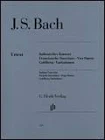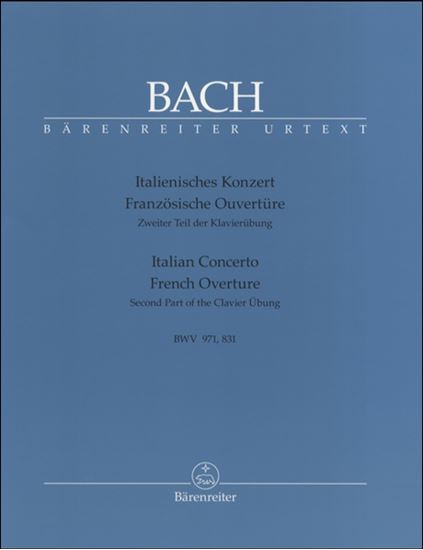Bach, Johann Sebastian : Italienisches Konzert BWV 971
Work Overview
Publication Year:1735
First Publisher:Weigel
Instrumentation:Piano Solo
Genre:pieces
Total Playing Time:12 min 00 sec
Copyright:Public Domain
Commentary (1)
Author : Asayama, Natsuko
Last Updated: June 20, 2007
[Open]
Author : Asayama, Natsuko
In 1735, Bach published the second part of his Clavier-Übung. Its first piece, written for a two-manual harpsichord, is titled "nach italienischem Gusto" (in the Italian taste), and is commonly known today as the Italian Concerto.
It consists of three movements: bright and lively outer movements and a graceful slow movement, following a fast-slow-fast structure. The opening motifs of these three movements show clear connections.
The published score unusually includes dynamic markings, namely "f" and "p," but these do not indicate the volume to be produced by the instrument itself. Following the convention of the concerto grosso (a concerto where multiple performing groups alternate or play together) of the time, these should be understood as indicating the alternation between tutti and solo, or, on a two-manual harpsichord, the change of keyboard. This represents a change in timbre rather than a change in volume, and on a modern piano, a richer expression is possible than on a harpsichord. This may also be why the work remains widely loved today.
However, it cannot be simply regarded as a transcription of an Italian instrumental concerto, such as those exemplified by Vivaldi's style, for the harpsichord.
From the "f" and "p" markings Bach included in the published score, the clear alternation between ritornello (recurring sections) and episode (developing sections), or between solo and accompaniment parts, is not evident. In the first movement, the ritornello at both ends is indeed clear. However, in the middle section, while the main musical phrases repeatedly attempt to emerge from various intertwining melodic lines, they do not fully recapitulate the theme, and the phrases proceed interwoven and disentangled without finding a clear break. Bach clearly desired a freer and more complex development here than a simple, clear contrast. The third movement can be described as somewhat contrapuntal, with each voice being relatively independent. Furthermore, intricate motivic development is incorporated, maintaining a high density despite the work's apparent simplicity.
From these points, it should be said that this work is not merely "in the Italian taste" but rather richly embellished with Italianate motifs and idioms. The rhythm at the beginning of the first movement was, according to J. Mattheson, a writer active in Hamburg in the first half of the 18th century, "the latest fashion." The richly ornamented aria in the second movement, supported by an ostinato (a repeated rhythmic or melodic pattern in the accompaniment), strongly evokes Vivaldi's own works. However, as the aesthetician J. A. Scheibe, a contemporary of Bach, praised it as "almost inimitable for foreigners," the essence of the work lies in its German-style thematic development and the overcoming of schematic forms. This spirit would eventually culminate in the clavier sonatas of the early Classical period.
Movements (3)
PTNA & Partner Channel Videos(14items) View More
Sheet MusicView More
Scores List (32)

(株)全音楽譜出版社

(株)春秋社

(株)全音楽譜出版社

KMP(ケイ・エム・ピー) ケイエムピー

KMP(ケイ・エム・ピー) ケイエムピー

(株)リットーミュージック

KMP(ケイ・エム・ピー) ケイエムピー

(株)リットーミュージック

(株)全音楽譜出版社

(株)ヤマハミュージックエンタテインメントホールディングス

(株)シンコーミュージックエンタテイメント

ハンナ(ショパン)

(株)ヤマハミュージックエンタテインメントホールディングス

(株)シンコーミュージックエンタテイメント

(株)全音楽譜出版社

(株)全音楽譜出版社

(株)音楽之友社

ヘンレー

ヘンレー

(株)新芸術社

ヘンレー

ヘンレー

ヘンレ社(ヤマハ)
























